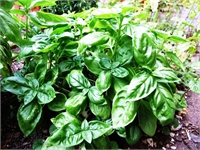
How to Grow Basil in Your Herb Garden
Important Notice: Our web hosting provider recently started charging us for additional visits, which was unexpected. In response, we're seeking donations. Depending on the situation, we may explore different monetization options for our Community and Expert Contributors. It's crucial to provide more returns for their expertise and offer more Expert Validated Answers or AI Validated Answers. Learn more about our hosting issue here.

How to Grow Basil in Your Herb Garden
You must be logged in to post a comment.
Basil, a relative of mint, is widely popular in worldwide cooking, from Italian to Asian and beyond. A resilient herb, it is among the easiest and most forgiving to grow. Because basil is so tolerant, it is a great starter for newcomers to herb gardening.
Direct Planting from Seeds
For the most successful crop, start your basil seeds outside where you plan to grow them. Wait a week or two beyond the last frost to protect the seeds and young plants from the dangers of a late frost. Basil likes warm soil and plenty of sunlight, so once the risk of frost passes, daily temperatures are at least 50 degrees and the soil warms, you can successfully start seeds.
Choose a planting area that contains well-draining soil. Add some peat moss or compost, but refrain from adding any fertilizer. Basil grows better in unfertilized soil unless your planting area has been stripped of all the natural nutrients in the soil. If that is the case, fertilize lightly then wait a day or two before you plant.
Plant the seeds in a shallow furrow. Seeds planted more than 1/4-inch deep may struggle to break the surface during germination. Cover the seeds lightly with soil then water them gently.
Start Seeds Indoors
If you choose to start seeds indoors and transplant the seedlings, plant the seeds six to eight weeks before the last frost. Place pots in a well-lit window or beneath an artificial light if necessary to ensure adequate sunlight.
Watering
Keep the seed beds moist. Dry seeds or overwatering basil will hinder germination and growth. Water basil plants well every 7 to 10 days, depending on the rainfall during that period. If the week’s weather has been very dry, water the plants more frequently. Skip watering for the week if there has been steady rain.
Pruning and Maintenance
When the basil seedlings sprout two to three full leaves, prune them so that your plants are 6 to 12 inches apart. Trim the plants regularly to encourage growth. Clip full stems just above a leaf pair so you do not impede new growth. If you fail to trim basil plants, they will begin to flower. Flowering basil becomes woody and slows the growth of the plant considerably. Replant fresh basil plants annually for the best flavor and growth.
Storage
Tie basil bunches together then hang them upside down to dry for several days before storing them in an airtight container. Place whole, fresh leaves into small freezer bags and freeze them for a fresher flavor as compared to drying.